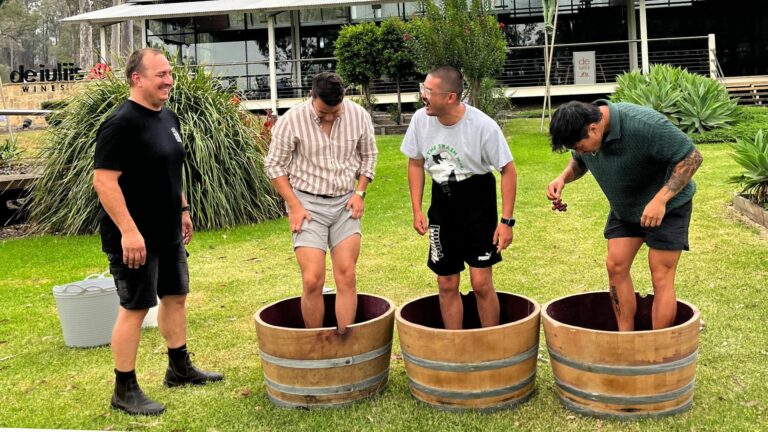
For centuries, the image of bare feet rhythmically crushing grapes in a large vat has been synonymous with winemaking. This time-honoured tradition, though less common today, holds a rich history and continues to fascinate wine enthusiasts. At De Iuliis, we appreciate the connection between tradition and innovation, and we invite you to explore the fascinating history of grape stomping.
The Dawn of Grape Stomping:
Grape stomping, also known as “pigeage” in French, dates back to ancient times. Evidence suggests that this practice was prevalent in ancient Greece and Rome, where it was a communal celebration and a vital part of the winemaking process. Depictions of grape treading can be found in ancient mosaics and artwork, showcasing its significance in their culture. The Romans, known for their sophisticated approach to viticulture, further refined the technique, understanding the importance of gently extracting tannins and colour from the grapes.
The Ritual and the Romance:
Beyond its practical purpose, grape stomping carried a certain romanticism. It was often a festive occasion, with music, dancing, and feasting accompanying the work. This communal activity fostered a connection to the land and the harvest. Imagine the feeling of the cool, pulpy grapes squishing between your toes, the sweet aroma of fermenting juice filling the air, and the camaraderie of shared labour. It’s easy to see why this tradition has captured the imagination for generations.
The Science Behind the Stomp:
While seemingly simple, grape stomping plays a crucial role in the winemaking process. The gentle pressure of human feet is less likely to crush the grape seeds, which can impart bitter flavours to the wine. This method allows for a smoother extraction of tannins and colour compared to harsher, more modern crushing methods. The natural yeasts in the grape skins also contribute to fermentation.
The Decline of the Tradition (and its Revival):
With the advent of modern technology, grape stomping largely gave way to mechanical presses. These machines offered greater efficiency and control over the winemaking process. However, the romantic allure and the unique qualities imparted by foot-treading have led to a resurgence of interest in this traditional practice, particularly for small-batch, artisanal wines. Some wineries, like De Iuliis, continue to incorporate elements of conventional winemaking, appreciating the connection to heritage and the unique character it brings to their wines.
De Iuliis: Respecting Tradition, Embracing Innovation:
At De Iuliis, we understand the importance of honouring tradition while embracing innovation. While we primarily utilize modern winemaking techniques to ensure consistent quality and efficiency, we appreciate the rich history of grape stomping and its connection to winemaking. Understanding the past enhances our appreciation for the present and inspires us to create exceptional wines that reflect heritage and modern expertise.


